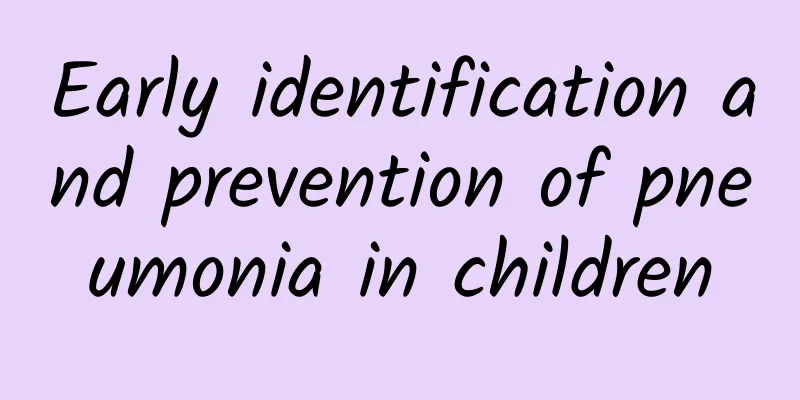Early identification and prevention of pneumonia in children

|
Pediatric pneumonia is a common respiratory disease in children and can occur all year round. Children with pneumonia generally have varying degrees of upper respiratory tract infection symptoms before the onset of the disease, such as fever, nasal congestion, runny nose, cough, vomiting, anorexia, etc., so it is difficult to detect in time that the child has progressed to the pneumonia stage. Pneumonia treatment takes a relatively long time. If it is not treated in time or the treatment is not thorough, it may lead to repeated attacks of pneumonia symptoms, and may become a direct cause of severe illness or complications, and have an adverse effect on the growth and development of children. Therefore, it is particularly important to understand the early identification and prevention of pediatric pneumonia. 1. What are the symptoms of pneumonia in children? Pneumonia usually develops a few days after an upper respiratory tract infection, and the first symptoms are often fever and cough. Auscultation of the lungs can hear relatively fixed fine wet rales (bubble sounds). If a chest X-ray or CT scan is taken, high-density shadows of varying sizes and degrees can be seen. Due to the weak constitution and insensitive cough reflex of infants, they may not have a fever or their body temperature may be lower than normal. The coughing is not obvious, and there will be symptoms such as foaming at the mouth, choking on milk, and refusing milk. In addition, babies with pneumonia generally have symptoms such as poor appetite, irritability and crying, poor spirits, or restless sleep. Severely ill children may have symptoms of breathing difficulties such as flaring of the nasal wings and blueness around the mouth. Some children may also have digestive system symptoms such as vomiting, abdominal distension, and diarrhea. Therefore, in order to identify pneumonia early, parents need to observe the baby's symptoms in detail. If a child has a high fever of more than 39°C for three consecutive days, frequent coughing, rapid breathing, wheezing, poor complexion, and poor spirits, it may be pneumonia. The child should be taken to the hospital as soon as possible. The doctor can perform differential diagnosis of pneumonia by auscultation of the lungs. If necessary, doctors can also perform imaging examinations (chest X-rays or CT scans) to further clarify the diagnosis of children suspected of pneumonia. 2. How to prevent pneumonia in children? Children are vulnerable to various microorganisms because their immune systems are not fully developed and their resistance is weak, especially those between 6 months and 2 years old. More than 2 million infants die from pneumonia every year worldwide. Malnutrition can weaken children's immune systems, especially in infants who are not fully breastfed. Children with underlying diseases such as diarrhea, measles or chickenpox can increase the risk of pneumonia. So how can we prevent it? First of all, the most economical and effective measure to prevent pneumonia is to get vaccinated against pneumonia. The pneumonia vaccine we are currently using is an effective vaccine against the most common pathogen in children, Streptococcus pneumoniae. Vaccination can induce an immune response in the human body, produce a large number of antibodies against pneumococcus, and effectively defend against the invasion of pneumococcus. Pneumococcal vaccine can be administered all year round. After one dose, protective antibodies can be produced within 2-3 weeks. Revaccination after 5 years can produce lasting immunity and benefit lifelong. Secondly, because infected patients can expel droplets from their mouths or noses through coughing, sneezing, talking, etc., it can be said that germs are everywhere in the air and can easily spread widely. Therefore, in addition to vaccination, we must also pay attention to keeping the home environment clean and airy, and regularly disinfect items that children touch on a daily basis. When colds are prevalent in society, try not to take children to public enclosed places, and remember to wear masks when going out. When someone at home has a cold, it is best not to contact children or wear a mask. In addition, insisting on physical exercise, strengthening children's physique, and constantly strengthening their disease resistance are also the key to preventing this disease. At the same time, we should also pay attention to changes in temperature, add or remove clothes for children at any time to avoid catching a cold. In terms of feeding, we should also develop good eating habits, wash hands before meals, avoid picky eating, eat less snacks, choose easy-to-digest, fresh food, and try to diversify the variety to ensure balanced nutrition for children. When children eat, they should concentrate, chew slowly, and not laugh while eating, so as to avoid choking on food and causing aspiration pneumonia. 3. How to treat pneumonia in children? If a child is unfortunately diagnosed with pneumonia, timely treatment is required. Mild pneumonia can be treated in outpatient clinics, and oral anti-infective drugs, cough suppressants, expectorants, and antipyretics can effectively alleviate the condition. However, it should be noted that antibiotics must be used under the guidance of a doctor to avoid the abuse of antibiotics that lead to bacterial resistance. For infants and seriously ill children, hospitalization is generally recommended. Inpatient treatment mainly includes general symptomatic supportive treatment, anti-infective treatment, traditional Chinese medicine and traditional Chinese medicine (low-frequency pulsed electrical therapy), a combination of nebulizer inhalation therapy and mechanically assisted expectoration. As the saying goes, 30% treatment and 70% care, the care of children with pneumonia also plays a very critical role in the recovery of the disease. The room of the child should be ventilated to keep the air fresh, and attention should be paid to keeping the child's airway unobstructed. Nasal crusts, nasal secretions and respiratory sputum should be removed in time. For those with a lot of thin sputum, you can turn over and pat your back regularly to facilitate the discharge of sputum. For those with thick sputum that is difficult to cough up, you can suction sputum or use ultrasonic atomization inhalation, or take expectorants orally. Pay attention to ensuring adequate fluid intake. Generally, children can maintain fluid intake through oral administration. For children with difficulty in eating or poor appetite, intravenous infusion can be used to supplement the fluid requirement. For young infants, breastfeeding should be tried as much as possible. If artificial feeding is used, the amount and concentration of milk can be determined according to their current digestive function and condition. If there is diarrhea, skim milk should be given. For older children, a light, easily digestible, and nutritious diet should be provided. Do not eat spicy, greasy, or irritating foods to avoid aggravating the condition. The course of treatment for pediatric pneumonia is generally about one week. Severe cases require longer treatment time. For example, lobar pneumonia or severe pneumonia requires 2-3 weeks or longer. Therefore, parents should not rush to discharge their children who are hospitalized. Do not assume that pneumonia is cured if the fever subsides or the cough is relieved. If the course of treatment is insufficient or the treatment is not thorough, the disease is likely to recur. In short, early identification and prevention of pediatric pneumonia requires parents' high attention and active participation. Parents can detect pediatric pneumonia in time by carefully observing the symptoms of their children and seeking help from doctors, so that early detection and early treatment can be achieved. Parents can effectively prevent pediatric pneumonia by taking measures such as vaccinating against pneumonia, keeping the living environment clean, strengthening exercise, and feeding properly. The course of treatment for pediatric pneumonia must be sufficient to ensure the healthy growth of children. (Lei Lirong, the Sixth People's Hospital of Longgang District, Shenzhen) |
<<: "Healthy through eating" series | Is instant noodles "junk food"? Four misunderstandings to know
>>: How can we get a reliable cancer screening that can cost thousands of dollars?
Recommend
Female Candida positive
If a woman tests positive for Candida, it means s...
Pain in the urethra and blood in urine in women
Women must pay more attention to protecting their...
What should I do if there are cysts in my ovaries?
Dear female friends, if your menstruation is alwa...
Feelings of the hardship of ten months of pregnancy
Pregnancy for ten months is a very difficult proc...
My period has not ended for more than ten days.
Menstruation is quite important for women. If the...
Is it true that Wuhan was unsealed for three hours? Why was Wuhan unsealed for three hours?
Recently, the news that Wuhan was unsealed three ...
What to eat during menstruation to lose weight with cupping?
Many weight loss methods are not feasible during ...
Pregnancy Exercise Plan
Some pregnant women have had miscarriages before,...
What to do if Chlorophytum comosum does not bloom for more than a year? What to do if Chlorophytum comosum does not bloom for more than a year?
Chlorophytum comosum is a plant of the genus Chlo...
New research: Once this core organ ages, the functions of the whole body will "regress"
The liver is an important detoxification organ in...
What does a woman's vagina look like?
The structure of female genitals is very complex,...
Right lower abdominal pain before menstruation
If you experience pain in the lower right abdomen...
Can I eat mushrooms during my period?
When it comes to mushrooms, many of my friends lo...
What to do if you have breast lipoma
Due to various reasons, the human body is prone t...
What effects does eating beef during pregnancy have on the fetus?
Is beef a food rich in protein? The iron content ...









